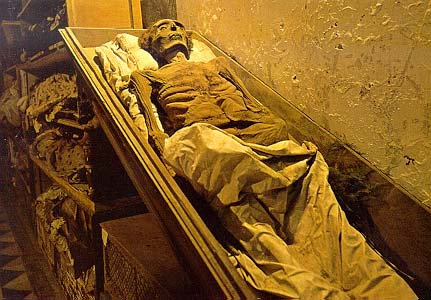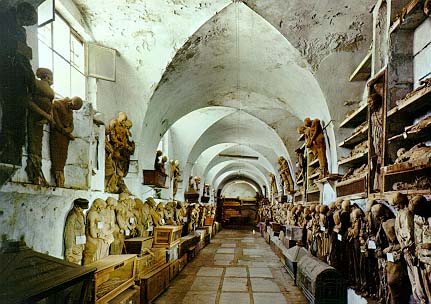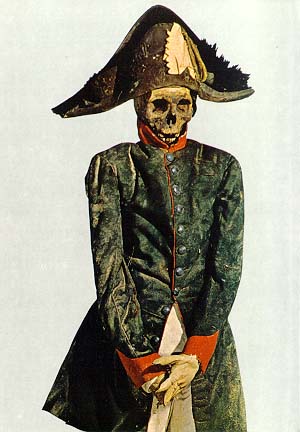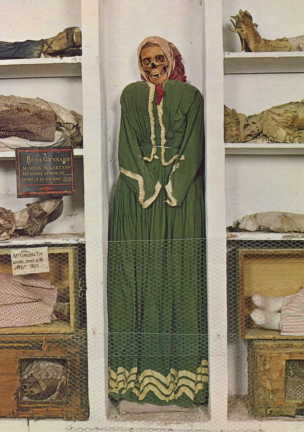"Welcome! This is a photographic trip to the Capuchins' Catacombs located in Palermo, Italy. There are thousands of corpses lined on the walls like paintings.

The catacombs date back to the 1599 when the local priests mummified a holy monk for all to see. They wanted to pray to him after death.
In time the locals wanted their relatives remembered in this same way. Soon there were hundreds of corpses. Some of the deceased wrote wills, expressing the clothes in which to bury them in. Some asked to have their clothes changed over a period of time. Included in the catacombs are hundreds of coffins as well. Some contain the corpse that was buried in them. The side is sometimes cut to expose the deceased.

Children are sometimes posed. Two are seated together in a small rocking chair. Rosalia Lombardo was one of the last corpses to make it to the catacombs before the local authorities discontinued the practice. Rosalia died about 1920 and is nicknamed the "Sleeping Beauty".

Some of the corpses have long ago lost their flesh and are skeletons. Others have mummified flesh, hair and even eyes! All are dressed in clothes from the period in which they lived. One such example is of Colonel Enea DiGiuliano. He is still wearing his 1800's French Bourbon uniform.

Several of the corpses seem to be "screaming" from the dead. Time and gravity have distorted the corpses to look this way. It is very creepy! Some have body parts which have fallen off over the years such as hands, jaws, parts of the skull, etc.

Upon entering the catacombs, one might think that the smell would be terrible, or at least musty. Yet, there was no trace of any odor. Many of the corpses were close enough to touch, if you were so inclined.
The method for embalming Rosalia Lombardo was invented by Dr. Solafia, a doctor in Palermo, who took the secret with him when he died. It is only known that it was based on injections of chemicals and nothing else.
A second method used was that of dipping the bodies in arsenic or lime. This was done espceially during periods of epidemics.
The most common method used was that of dehydration by placing the bodies in cells, situated along the passageways. These cells were called "strainers", and look like a BBQ pit. The bodies were dried in the cells for about eight months then taken out and washed in vinegar before being exposed to the fresh air. They were dressed and put in niches, coffins, or on the walls, as instructed by the person while still alive or by relatives after death.

Monks are buried in the clothes they wore in life. They sometimes have ropes, dangling from their necks. The ropes were worn by the monks, in life, as a penance. They remain with them in death. The first monk, and the oldest corpse, is that of Brother Silvestro from Gubbio who died in 1599. The last monk interred here was Brother Riccardo of Palermo, who died in 1871.

The halls are divided into catagories: Men, Women, Virgins, Children, Priests, Monks, and Professionals. The Professionals Hall includes at least one American, writers, lawyers, priests, and others.
The Professors' section contains the bodies of professors, doctors, lawyers, painters, officers and soldiers of the Bourbon and Italian army. Among the famous names are those of the painter Velasquez, the sculptors Filippo Pennino and Lorenzo Marabitti and the surgeon Salvatore Manzella.

The catacombs are located in Palermo, Sicily. Visiting hours are from 9 a.m. - 12 noon, and 3:30 p.m. - 5:30 p.m.
Directions: (as copied from the booklet from the Catacombs)"






























